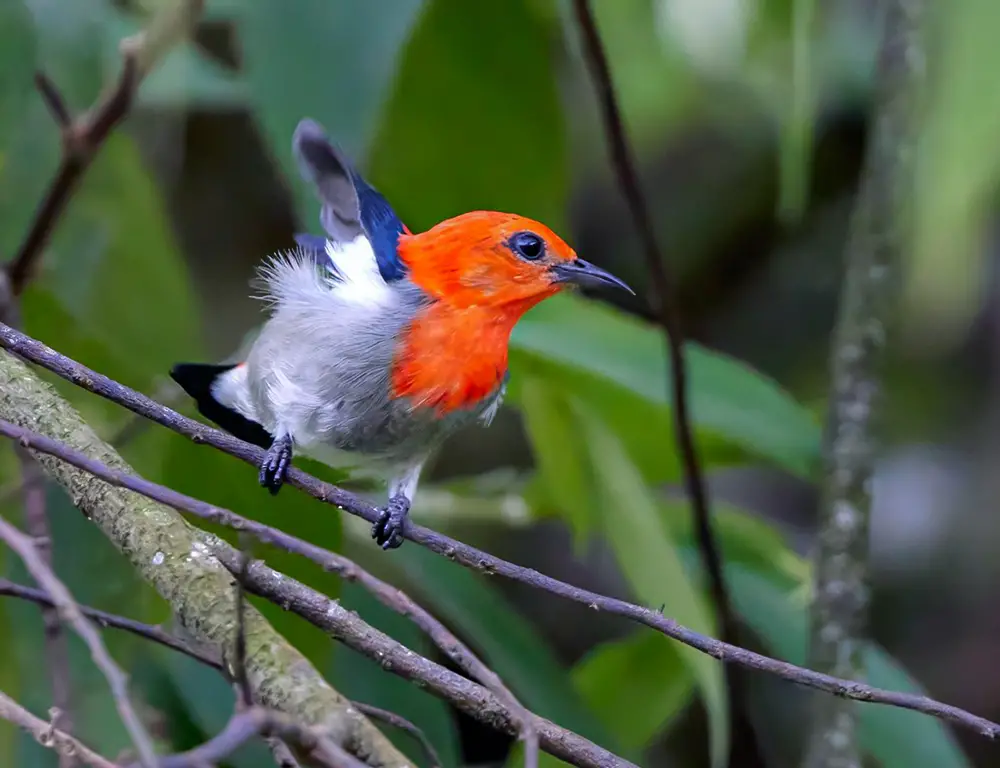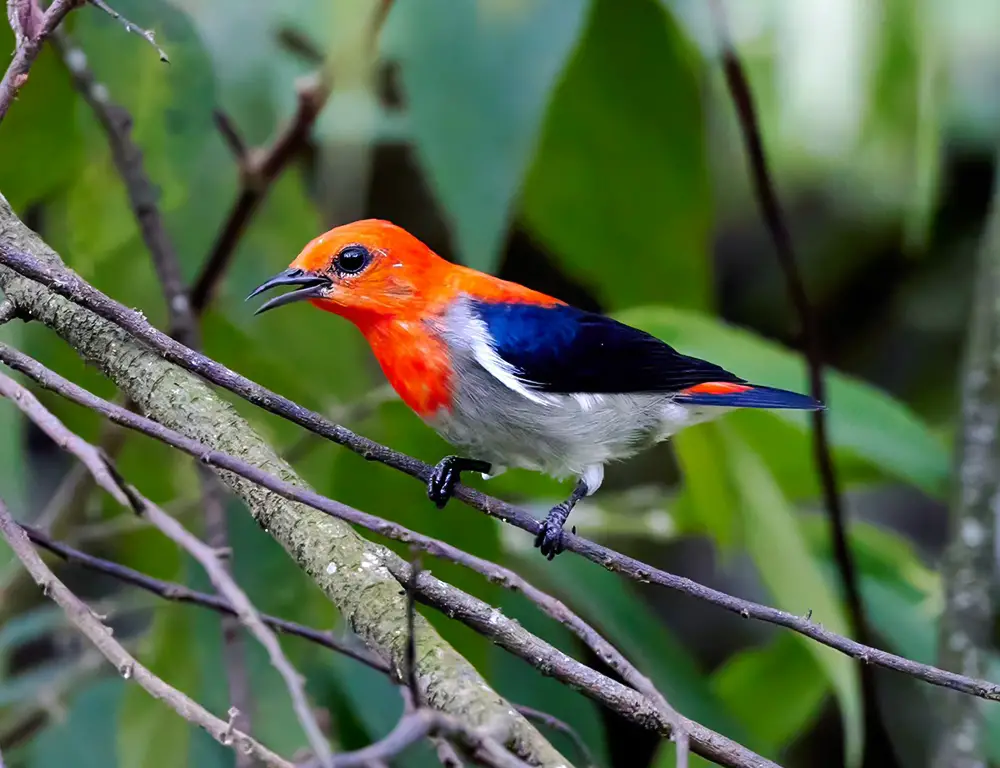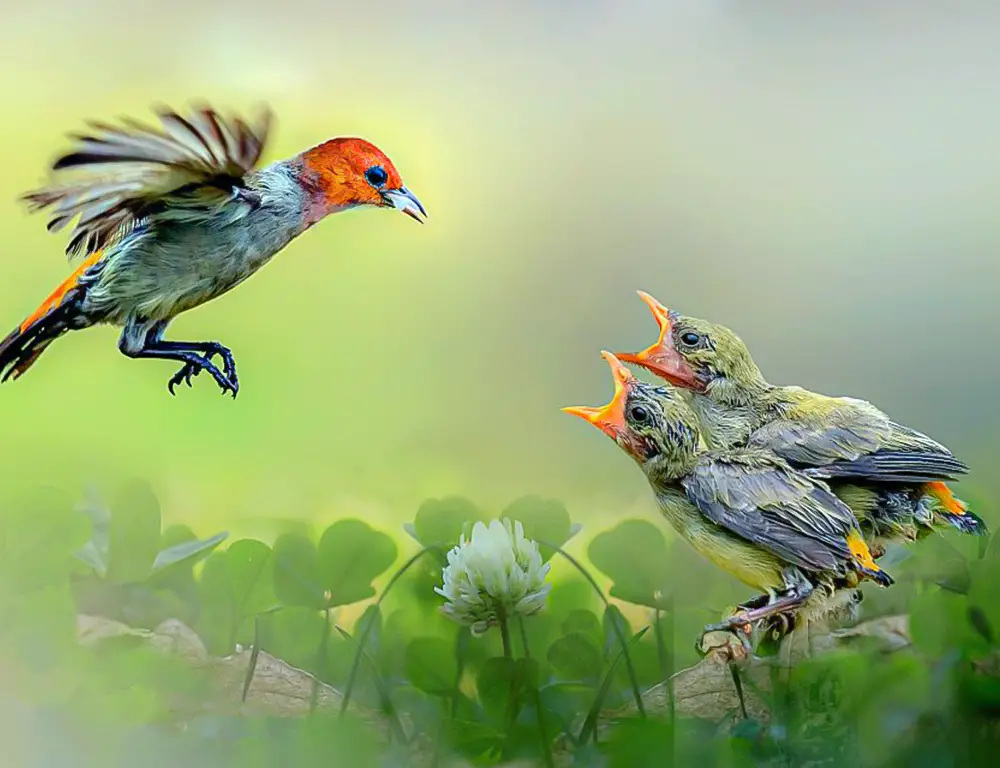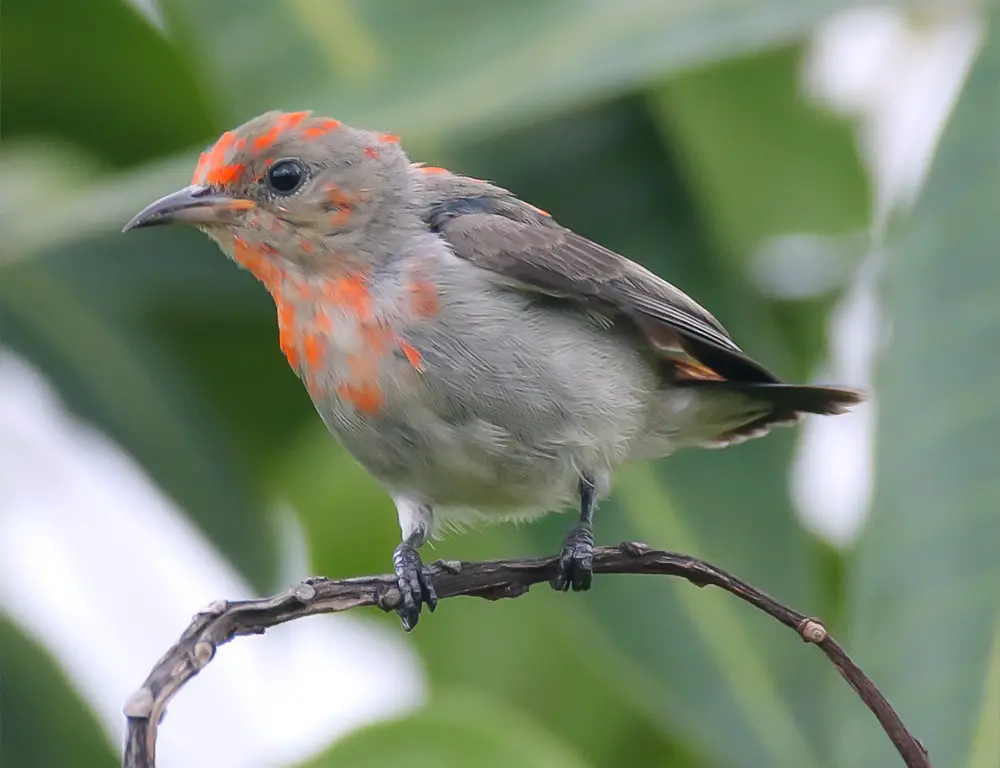When exploring nature, the Scarlet-Headed Flowerpecker might not be a bird that immediately catches your eye. That’s because it’s a tiny creature with an average length of just 9 cm (3.5 inches). But once you spot it and see its vibrant colors, I guarantee you’ll want to know more.
Now, let me tell you a bit about this unique feathered friend. The Scarlet-Headed Flowerpecker is native to Brunei, Indonesia, Malaysia, and Thailand.
It’s known for its distinct red head and breast – hence the name – coupled with black wings and tail. Its diet mainly consists of berries and insects.
The Scarlet-Headed Flowerpecker isn’t just beautiful; it also serves a vital role in maintaining our ecosystem by spreading seeds through their droppings – assisting in forest regeneration.
Understanding these birds could help us appreciate the finely tuned balance of our natural world even more!

Physical Characteristics of the Scarlet-Headed Flowerpecker
The Scarlet-Headed Flowerpecker, a tiny yet visually striking bird, possesses unique physical characteristics that distinguish it within the avian world.
Size and Color
On average, these birds measure approximately 9 cm in length, making them comparable in size to a human’s middle finger. Despite their small size, they weigh around 7 grams, roughly equivalent to two standard paper clips.
Their vivid coloration is notable, particularly in males exhibiting brilliant scarlet heads that sharply contrast their black bodies. Females, in contrast, display a more subdued olive green coloration with paler underparts.
Beak
One of the most remarkable features of Scarlet-Headed Flowerpeckers is their short and stout beaks, perfectly adapted for their fruit-based diet.
This specialized bill structure enables them to efficiently feed on small fruits and berries with ease, highlighting their adaptation to their dietary preferences.
Wingspan
Despite their petite size, Scarlet-Headed Flowerpeckers boast a wingspan ranging between 11 and 12 cm. This relatively large wingspan enables them to undertake long-distance flights when necessary, showcasing their remarkable aerial capabilities despite their small stature.
Legs
These birds possess strong legs well-adapted for gripping branches as they navigate their arboreal habitats. Their sturdy legs facilitate agile movements, allowing them to hop from tree to tree in search of food or while evading potential predators.
Habitat and Distribution of the Scarlet-Headed Flowerpecker

With its vibrant colors and small size, the Scarlet-Headed Flowerpecker inhabits various Southeast Asian regions, exhibiting a diverse distribution pattern across different countries.
Geographic Range
These birds are primarily found in Malaysia, Brunei, Indonesia, and Thailand. However, their presence varies significantly across these countries. They are common in Malaysia, widespread in Indonesia, rare in Brunei, and have a limited presence in Thailand.
Preferred Habitats
Scarlet-headed flowerpeckers display adaptability to various habitats. However, they exhibit preferences for specific environments:
- Tropical Rainforests: They thrive in tropical rainforests, where the dense foliage provides ample cover and a rich diversity of flowers ensures a steady food supply. These habitats offer ideal conditions for their survival and reproduction.
- Mangrove Forests: Scarlet-headed flowerpeckers also adapt well to mangrove forests, utilizing the complex root systems as a suitable habitat. Mangrove forests provide unique ecological niches, and these birds are adept at exploiting them.
- Cultivated Areas and Gardens: Surprisingly, Scarlet-Headed Flowerpeckers are not opposed to human habitation. They are often found in cultivated areas and gardens, especially those with fruit-bearing trees or flowering plants. This adaptability to anthropogenic landscapes demonstrates their ability to coexist with human activities.
Conservation Concerns
Despite their adaptability to different habitats, Scarlet-Headed Flowerpeckers face significant habitat loss and deforestation threats.
As human activities continue to infringe upon their natural habitats, it is imperative to consider the conservation of these species and their ecosystems.
Preserving the integrity of tropical rainforests and mangrove ecosystems is crucial for Scarlet-Headed Flowerpeckers and other wildlife species that rely on these habitats.
Behavior and Diet of the Scarlet-Headed Flowerpecker

Scarlet-headed flowerpeckers, small yet vibrant birds with a penchant for nectar, exhibit intriguing behaviors that set them apart from other bird species. Their diet primarily consists of nectar derived from various flowers, but they also consume small insects and fruits.
Feeding Behavior
Diving right into their feeding habits, these birds display an affinity for hanging upside down while sipping on the sweet nectar of tropical flowers. They’re perfectly adapted to this acrobatic style of dining thanks to their strong claws and flexible bodies.
When it’s not flower season, or food is scarce, they switch their menu to include small insects and berries.
Their fondness for solitude extends to meal times as they feed alone. However, when food is abundant during peak flowering seasons, you might spot groups congregating around a vibrant nectar source.
It’s worth noting that Scarlet-Headed Flowerpeckers play an essential role in pollination. As they flit from flower to flower, seeking the sweetest treats, pollen sticks onto their beaks and gets transferred, facilitating cross-pollination among plants.
Breeding Behavior
Moving on to their breeding behavior – it’s pretty fascinating! The courtship ritual involves the Male displaying his bright scarlet head and chest plumage in front of potential mates – visual cues are key here!
Once paired up, both parents collaborate in building a nest, which is often camouflaged amongst foliage high up in trees for safety against predators. Only the female incubates the eggs while the male stands guard nearby.
These creatures’ mating period usually occurs during wet seasons when food resources are plentiful, ensuring a higher survival rate for their offspring.
After two weeks post-hatching, fledglings leave the nest under watchful parental guidance until fully independent.
In summary (though there’s so much more to these beautiful birds), the Scarlet-Headed Flowerpeckers’ behavior and diet are a testament to their adaptability and resilience in the wild.
Their acrobatic feeding habits, solitary nature, significant role in pollination, and collaborative breeding behaviors paint a picture of a species that is as intricate as it is vibrant.
Conservation Status of Scarlet-Headed Flowerpecker

The Scarlet-Headed Flowerpecker, with its vibrant colors and unique behaviors, is currently classified as Least Concern (LC) by the International Union for Conservation of Nature (IUCN).
This designation indicates that the species is not facing immediate threats of extinction, primarily due to its stable population trend and expansive range across Southeast Asia.
However, despite this relatively positive classification, it’s crucial to recognize that the “Least Concern” status does not imply immunity from conservation concerns.
Human activities such as deforestation, habitat degradation, and land conversion for agricultural expansion or urban development still pose significant threats to the Scarlet-Headed Flowerpecker’s natural habitats.
To mitigate these threats and ensure the continued well-being of this species, various conservation efforts are being implemented:
- Forest Protection Laws: Enacting and enforcing laws and regulations to protect vital forest habitats where Scarlet-Headed Flowerpeckers reside can help safeguard their populations from habitat loss and degradation.
- Sustainable Farming Practices: Promoting and implementing sustainable farming methods that minimize the impact on natural habitats can help reduce deforestation and habitat fragmentation, thereby preserving suitable environments for these birds.
- Population Surveys: Conducting regular population surveys and monitoring initiatives to assess the status and trends of Scarlet-Headed Flowerpecker populations can inform conservation strategies and management actions.
Conclusion
So, that wraps up our journey through the colorful world of the Scarlet-Headed Flowerpecker. I’ve shared this bird’s striking physical characteristics, habitat preferences, and unique behaviors with you. We’ve also touched upon how crucial protecting these vibrant birds and their habitats is.
The main takeaway from our discussion? The Scarlet-Headed Flowerpecker isn’t just a pretty face in the avian world – it also plays an essential role in its ecosystem. Remember, they’re pollinators and seed dispersers, tasks vital for maintaining biodiversity in their habitats.
Here’s a quick recap of what we’ve learned about these fascinating birds:
- Their distinctive scarlet head and neck make them easy to spot.
- They favor forest edges and gardens with fruiting trees.
- They play a significant role as pollinators and seed dispersers in their ecosystems.
Looking forward, let’s hope that conservation efforts continue to protect these brilliant birds and their homes. After all, every species matters when preserving our planet’s rich biodiversity.
I hope you enjoyed learning about the Scarlet-Headed Flowerpecker as much as I did writing about it! It truly is one of nature’s splendid splashes of color worth protecting.
As we continue exploring other amazing creatures around the globe, remember that understanding leads to appreciation; appreciation leads to protection.